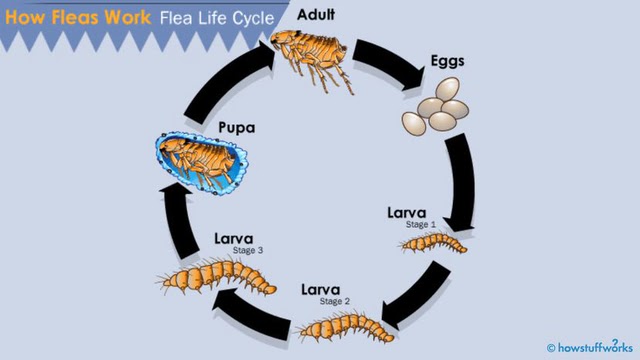Quck answer
Fleas are blood-sucking parasites that infest mammals and birds. They have strong legs that allow them to jump up to 200 times their body length. Fleas use their sharp mouthparts to pierce the skin and suck blood from their host. They are known carriers of diseases such as bubonic plague and murine typhus. Fleas have a life cycle consisting of egg, larva, pupa, and adult stages. They can survive for months without a host and can lay hundreds of eggs in their lifetime. Controlling fleas involves treating both the host and the environment to prevent re-infestation.
Wild Animals
The Life Cycle of Fleas Explained

The life cycle of a flea is quite similar to that of a butterfly.
When it comes to reproduction, fleas follow a process that is quite similar to that of butterflies. The female lays eggs which later hatch into worm-like larvae. The larvae eventually spin cocoons and emerge as adult fleas. In a group of fleas, about 50% are eggs and only 5% are adults.
Female fleas can only lay eggs after they have had a proper meal. If a female flea is unable to find food, she dies without reproducing. Once the female has had a meal, she can lay up to 20 eggs at a time, and up to 500 eggs during her lifetime.
Fleas usually lay their eggs on their host, but the eggs are quite smooth and can easily slide off and land in the environment around them. In homes, flea eggs can settle deep into carpet fibers and floor cracks. Outside, they settle into the soil. Flea eggs are white, while the black specks you see on flea-infested areas are particles of dried blood and flea droppings.
Flea eggs require a warm, moist environment with a temperature of about 70 degrees Fahrenheit (21 degrees Celsius) and 70 to 85 percent humidity to develop. In these conditions, the eggs hatch in about 12 days. This 12-day window can make it hard to get rid of fleas since some insecticides only kill adult fleas, not eggs. This means that a whole new set of fleas can emerge after the adults have died.
Flea larvae are white, segmented worms, about 0.5 inches (1.5 millimeters) long. They avoid light and tend to migrate towards cracks in the floor, where they remain for their development. Unlike their parents, the larvae don’t feed on blood. Instead, they feed on skin cells, flea droppings, and other debris. Larvae develop through three stages, or instars, and molt after each stage.
After a week or two, flea larvae spin silk cocoons. They attach dirt and debris to their cocoons to camouflage themselves. If food is plenty, the adult flea emerges after about a week. If not, the flea may stay in its cocoon for up to a year.
Although flea larvae and adults have completely different eating patterns, what they eat has a significant impact on the diseases fleas can carry. Next, we’ll take a look at flea-borne illnesses and complications from flea bites.
FAQ
1. What are fleas?
Fleas are small, wingless parasitic insects that feed on the blood of warm-blooded animals, including humans, dogs, and cats. They have flattened bodies, powerful legs for jumping, and sharp mouthparts for piercing skin and sucking blood.
2. How do fleas reproduce?
Fleas reproduce quickly and in large numbers. Female fleas lay eggs on their host animal or in its environment, such as bedding or carpet. Eggs hatch into larvae, which feed on organic matter before transforming into pupae. Pupae eventually emerge as adult fleas, ready to start the cycle all over again.
3. What are the symptoms of flea bites?
Flea bites can cause itching, redness, and swelling. In some cases, they can also transmit diseases, such as the bubonic plague. Pets may also experience hair loss, skin irritation, and anemia if they are heavily infested with fleas.
4. How do fleas spread?
Fleas can spread from animal to animal through direct contact, or from the environment, such as shared bedding or carpet. They can also hitch a ride on humans and other animals, making it easy to spread them to new locations.
5. How can I prevent flea infestations?
Prevention is key when it comes to fleas. Regularly grooming and bathing pets, vacuuming carpets and furniture, and keeping bedding clean can all help prevent flea infestations. In addition, using flea prevention products, such as topical treatments or collars, can also be effective.
6. How do flea treatments work?
Flea treatments work by killing adult fleas and preventing their eggs from hatching. There are many different types of flea treatments available, including topical treatments, oral medications, and flea collars. It’s important to follow the instructions carefully and consult with a veterinarian before using any flea treatment.
7. Can fleas survive on humans?
Fleas can feed on humans, but they do not typically infest human hosts. However, if a home is heavily infested with fleas, it is possible for humans to get bitten and experience discomfort and itching.
8. What are some natural remedies for flea control?
There are many natural remedies for flea control, including diatomaceous earth, essential oils, and vinegar. However, it’s important to use caution when using these remedies and consult with a veterinarian first.
9. When should I consult a veterinarian for flea control?
If you are experiencing a flea infestation or have concerns about flea prevention, it’s best to consult with a veterinarian. They can recommend the best flea prevention products and treatments for your specific pet and situation.





Leave a Reply